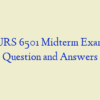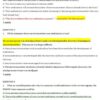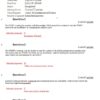Description
NURS 6630 Midterm Exam – Question and Answers
- Which drug below has an interaction with cigarette smoking and should be adjusted based on patient’s tobacco use/non-use?
- Which of the following medications is best to AVOID in maintenance treatment of bipolar disorder and why?
- Glia cells play a supportive role in the neuron. A few of the functions of the glial cells include providing nutrition, maintaining homeostasis, stabilizing synapses, and myelinating axons. The glial cells are categorized as microglia or macroglia. Of the macroglia cells, which one plays a role in myelinating axons, which may contribute to mood disorders if altered?
- Which of the following are NOT primary target(s) symptom for antipsychotic agents in schizophrenia?
- A 32-year-old males calls you complaining of decreased libido since starting Paroxetine 20 mg 2 weeks ago. He reported stopping the medication 1 day ago and is now experiencing extreme irritability and nervousness. He wishes to stop this medication due to side effects. What do you recommend?
- With second-generation antipsychotics, what is the main side effect that requires frequent monitoring?
- A 23-year-old female was just diagnosed with major depressive disorder and is being started on escitalopram 10 mg daily. The patient should be counseled about which Black Box warning?
- Which anticonvulsant below induces its own metabolism over time?
- In order for the NMDA receptor to fully open and allow an influx of calcium, both glutamate and glycine must bind to cause a depolarization of the cell that will ultimately displace which ion? Is the NMDA receptor an ionotropic or metabotropic receptor?
- Which of the following medications are known as selective serotonin re-uptake inhibitors (SSRIs)?
- Which disease state of a non-adherent patient is at greater risk for substance use, violence, and victimization as well as worse overall quality of life?
- An 81-year-old male comes to your clinic today complaining of dry mouth, blurred vision, and constipation. He has a past medical history significant for hypertension, heart failure, and depression. Of the following medications, which one is likely contributing to these side effects?
- Choose the appropriate statement regarding lamotrigine dosing.
- Of the following medications used in the treatment of social anxiety disorder, which one would you AVOID in a patient who has uncontrolled hypertension?
- What is the therapeutic plasma level of carbamazepine?
- Which of the following statements below is NOT considered an appropriate treatment strategy for treatment-resistant depression?
- Choose the correct statement(s) regarding lithium levels. SELECT ALL THAT APPLY.
- How do you manage a patient who develops neuroleptic malignant syndrome while on an atypical antipsychotic?
- When initiating lithium, how long should you wait before checking a lithium level? What is the therapeutic goal level of lithium?
- K. B. never felt relief from his depressive symptoms, even after appropriate time and dose titration of Venlafaxine. He was switched to Bupropion 150 mg about 2 months ago and is following up with you today. He reported feeling “great” and that his relationship with his girlfriend is “better than ever now.” Because he is feeling so well at this time, he is wondering when he can stop taking Bupropion. How long must the patient be symptom-free before he may begin a trial to taper off the antidepressant therapy?
- Choose the appropriate pair regarding acetylcholine receptors.
- Which neurotransmitter is considered the major inhibitory neurotransmitter?
- M. B. was just diagnosed with Generalized Anxiety Disorder and pharmacotherapy is needed. Which of the following would be a first-line treatment option for M. B.?
- Close-ended questions will help identify when patients are taking medications incorrectly.
- Of the following medications, which ones are considered first-line in treatment of an acute manic episode of bipolar disorder (assuming monotherapy)?
- Which answer choice includes all the components of patient-focused interventions to enhance adherence?
- Which medication has been studied and recommended in patients with a social anxiety disorder who also suffer from an alcohol use disorder?
- Choose the correct option regarding the major classes of GABA receptors and the ions involved in inhibition of the neurotransmitter pathway.
- Which atypical antipsychotic(s) require a meal for better absorption?
- K. T. is a 35-year-old woman who was diagnosed with Generalized Anxiety Disorder about 4 weeks ago. She was prescribed Clonazepam 2 mg at bedtime but was referred to you to determine chronic treatment. K. T. states the new medication has been helping a lot but worries about all the side effects that come with it. She wants to discontinue the medication. What is the appropriate next step to help K. T.?
- The serotonin system is involved in many processes in psychiatry, including, most prominently, mood, sleep, and psychosis. Of the following neurons listed, from where is serotonin synthesized?
- A 27-year-old female presents to your emergency room today with a rash that started about 1 week ago and has now spread to her whole body. She has a past medical history significant for type 2 diabetes, hypertension, and bipolar disorder. The patient reports, “The only thing that is different is that I’ve been on this new medication for my bipolar for a few weeks.” Of the following medications, which one is likely to be causing this severe rash?
- The following patient case is considered an example of treatment-resistant depression. B. B. is a 26-year old-female at your clinic today with the diagnosis, “treatment-resistant depression.” She is currently on Bupropion 300 mg daily and has been at this dose for 6 weeks with no alleviation in depressive symptoms. She has trialed the following medications in the past with treatment duration listed:
- Patient is a 72-year-old male with a past medical history significant for atrial fibrillation and COPD with a new diagnosis of major depression disorder. Based on his comorbid conditions, what antidepressant would you recommend as first-line?
- It is appropriate to start lamotrigine in combination with another atypical antipsychotic in treatment of an acute manic episode in bipolar disorder.
- Which statement is TRUE regarding the use of selective serotonin reuptake inhibitors (SSRI)/serotonin-norepinephrine reuptake inhibitors (SNRI) in patients with Generalized Anxiety Disorder?
- Which of the following is an appropriate strategy for managing treatment-resistant depression?
- Which of the following medications used for treatment of bipolar disorder may increase stroke risk among older patients, particularly those with dementia?
- Which amino acid is involved in the synthesis of both norepinephrine and dopamine?
- Which of the following symptoms is NOT part of the diagnostic features for bipolar disorder?
- Which antiepileptic drugs should we avoid in pregnant women in the treatment of bipolar disorder?
- Which drug below differs from other atypical antipsychotics in causing persistent hyperprolactinemia?
- A 25-year-old female comes into your clinic today informing you she is ready to have a baby and wishes to discontinue her birth control at this time. After reviewing her chart, you notice she has a history of bipolar disorder and was previously prescribed valproic acid by another doctor. What is your concern with this medication in this specific patient?
- K. B. is a 28-year-old male who was started on Venlafaxine 75 mg about 2 weeks ago and is now calling you asking how long it should take for this medication to begin to work. He is concerned his girlfriend will leave him if he doesn’t get better quickly. What is the appropriate amount of time to allot to see a therapeutic response?
- Which of the following receptors below would likely result in extra-pyramidal symptoms, tardive dyskinesia, and hyperprolactinemia?
- Patient is a 59-year-old male with a past medical history significant for bipolar disorder I, hypertension, and COPD. He calls your clinic today complaining of extreme fatigue and a new tremor in his hand. He reports starting lithium 600 mg at bedtime about 5 days ago and thinks that may be the cause. What is the appropriate next step for this patient?
- What is the strongest established risk factor for bipolar disorder?
- Selection of an antipsychotic agent is usually guided by the side-effect profile and by available formulations.
- Of the following antipsychotic medications listed below, which one has a Black Box Warning for seizure, agranulocytosis, and seizures?
- M. M. is 27-year-old female student pharmacist who presents to the ER after experiencing extreme lightheadedness during her fourth-year seminar presentation. Her vitals are as follows: BP (107/65) and HR of 45. What medication below is likely the cause of these symptoms?







